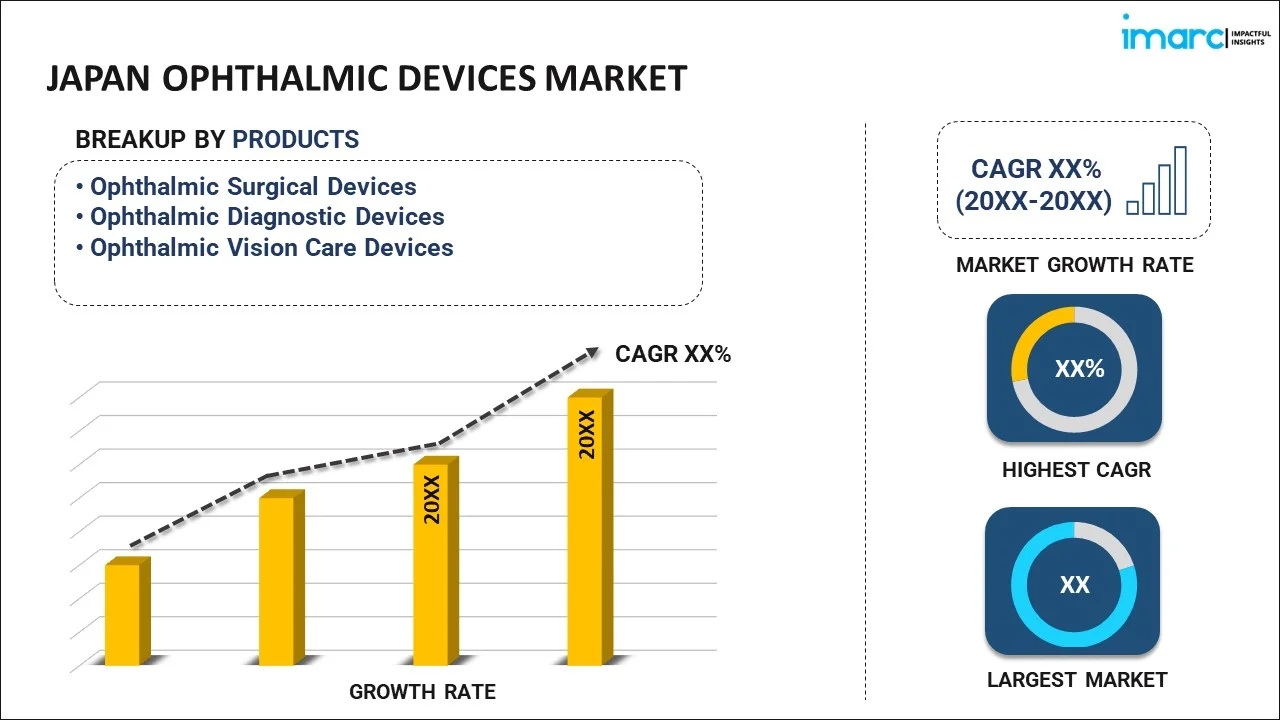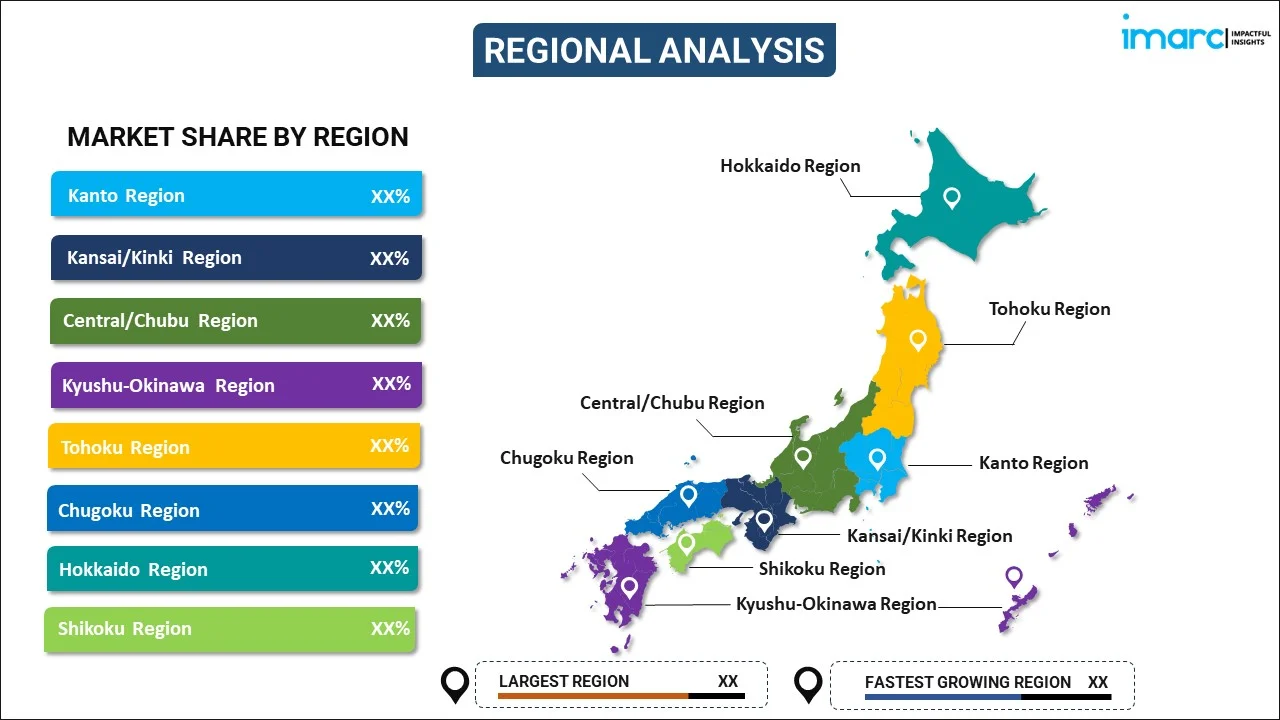
Japan Ophthalmic Devices Market Report by Product (Ophthalmic Surgical Devices, Ophthalmic Diagnostic Devices, Ophthalmic Vision Care Devices), Application (Cataract, Vitreo Retinal Disorders, Glaucoma, Refractor Disorders), End User (Hospitals, Ophthalmic Clinics, and Others), and Region 2025-2033
Market Overview:
Japan ophthalmic devices market size reached USD 1,691 Million in 2024. Looking forward, IMARC Group expects the market to reach USD 2,024 Million by 2033, exhibiting a growth rate (CAGR) of 2% during 2025-2033. The rising awareness among individuals towards visual impairment, along with the rising reliance on consumer electronic devices, is primarily catalyzing the regional market.
|
Report Attribute
|
Key Statistics
|
|---|---|
|
Base Year
|
2024
|
|
Forecast Years
|
2025-2033
|
|
Historical Years
|
2019-2024
|
| Market Size in 2024 | USD 1,691 Million |
| Market Forecast in 2033 | USD 2,024 Million |
| Market Growth Rate 2025-2033 | 2% |
Ophthalmic devices are specialized instruments employed for diagnosing eye conditions and facilitating vision improvement. These tools encompass items such as contact lenses, solutions for lens care, diagnostic tools, implantable devices, intraocular lenses (IOLs), laser equipment, phacoemulsification systems, synthetic tears, and various surgical tools. They are essential for identifying and treating eye irregularities, vision challenges, and other ocular diseases. These devices streamline eye care procedures, making them more efficient and enhancing the quality of care for both patients and eye specialists. They are extensively utilized, owing to the increasing prevalence of cataracts, glaucoma, and other vision-related conditions in Japan.
Japan Ophthalmic Devices Market Trends:
The Japan ophthalmic devices market stands as a significant sector within the country's healthcare industry, showcasing consistent growth backed by innovative developments and heightened demand. One driving force is the rising demand for ophthalmic devices like intraocular lenses (IOLs) and diagnostic instruments. Additionally, innovative advancements play a pivotal role in shaping the market's landscape. With the rise of digitalization, tele-ophthalmology has emerged as a notable trend, allowing patients to consult with specialists remotely, especially beneficial during times when in-person consultations are challenging. Moreover, the elevating integration of AI and machine learning in diagnostic equipment has enhanced accuracy and predictive analysis capabilities in detecting eye anomalies early on, which is acting as another significant growth-inducing factor. Another driving factor is the government's supportive stance towards research and development in the medical sector. Their favorable regulatory policies and incentives have propelled local manufacturers to invest heavily in R&D activities, leading to the introduction of cutting-edge ophthalmic devices in the market. Furthermore, increased public awareness about eye health and regular check-ups, combined with the availability of advanced treatment options, further accelerates the growth of the ophthalmic devices market in Japan. Besides this, the synergy of technological progress, demographic shifts, and governmental support are projected to fuel the regional market in the coming years.
Japan Ophthalmic Devices Market Segmentation:
IMARC Group provides an analysis of the key trends in each segment of the market, along with forecasts at the country level for 2025-2033. Our report has categorized the market based on product, application, and end user.
Product Insights:

- Ophthalmic Surgical Devices
- Refractive Error Surgical Devices
- Glaucoma Surgical Devices
- Cataract Surgery Devices
- Vitreoretinal Surgical Devices
- Ophthalmic Diagnostic Devices
- Refractors
- Corneal Topography Systems
- Retinal Ultrasound Systems
- Fundus Camera
- Ophthalmoscopes
- Optical Coherence Tomography Systems
- Perimeters
- Slit Lamps
- Tonometer
- Ophthalmic Vision Care Devices
- Contact Lenses
- Spectacle Lenses
The report has provided a detailed breakup and analysis of the market based on the product. This includes ophthalmic surgical devices (refractive error surgical devices, glaucoma surgical devices, cataract surgery devices, and vitreoretinal surgical devices), ophthalmic diagnostic devices (refractors, corneal topography systems, retinal ultrasound systems, fundus camera, ophthalmoscopes, optical coherence tomography systems, perimeters, slit lamps, and tonometer), and ophthalmic vision care devices (contact lenses and spectacle lenses).
Application Insights:
- Cataract
- Vitreo Retinal Disorders
- Glaucoma
- Refractor Disorders
A detailed breakup and analysis of the market based on the application have also been provided in the report. This includes cataract, vitreo retinal disorders, glaucoma, and refractor disorders.
End User Insights:
- Hospitals
- Ophthalmic Clinics
- Others
The report has provided a detailed breakup and analysis of the market based on the end user. This includes hospitals, ophthalmic clinics, and others.
Regional Insights:

- Kanto Region
- Kansai/Kinki Region
- Central/ Chubu Region
- Kyushu-Okinawa Region
- Tohoku Region
- Chugoku Region
- Hokkaido Region
- Shikoku Region
The report has also provided a comprehensive analysis of all the major regional markets, which include Kanto Region, Kansai/Kinki Region, Central/ Chubu Region, Kyushu-Okinawa Region, Tohoku Region, Chugoku Region, Hokkaido Region, and Shikoku Region.
Competitive Landscape:
The market research report has also provided a comprehensive analysis of the competitive landscape. Competitive analysis such as market structure, key player positioning, top winning strategies, competitive dashboard, and company evaluation quadrant has been covered in the report. Also, detailed profiles of all major companies have been provided.
Japan Ophthalmic Devices Market Report Coverage:
| Report Features | Details |
|---|---|
| Base Year of the Analysis | 2024 |
| Historical Period | 2019-2024 |
| Forecast Period | 2025-2033 |
| Units | Million USD |
| Scope of the Report | Exploration of Historical Trends and Market Outlook, Industry Catalysts and Challenges, Segment-Wise Historical and Future Market Assessment:
|
| Products Covered |
|
| Applications Covered | Cataract, Vitreo Retinal Disorders, Glaucoma, Refractor Disorders |
| End Users Covered | Hospitals, Ophthalmic Clinics |
| Regions Covered | Kanto Region, Kansai/Kinki Region, Central/ Chubu Region, Kyushu-Okinawa Region, Tohoku Region, Chugoku Region, Hokkaido Region, Shikoku Region |
| Customization Scope | 10% Free Customization |
| Post-Sale Analyst Support | 10-12 Weeks |
| Delivery Format | PDF and Excel through Email (We can also provide the editable version of the report in PPT/Word format on special request) |
Key Questions Answered in This Report:
- How has the Japan ophthalmic devices market performed so far and how will it perform in the coming years?
- What has been the impact of COVID-19 on the Japan ophthalmic devices market?
- What is the breakup of the Japan ophthalmic devices market on the basis of product?
- What is the breakup of the Japan ophthalmic devices market on the basis of application?
- What is the breakup of the Japan ophthalmic devices market on the basis of end user?
- What are the various stages in the value chain of the Japan ophthalmic devices market?
- What are the key driving factors and challenges in the Japan ophthalmic devices?
- What is the structure of the Japan ophthalmic devices market and who are the key players?
- What is the degree of competition in the Japan ophthalmic devices market?
Key Benefits for Stakeholders:
- IMARC’s industry report offers a comprehensive quantitative analysis of various market segments, historical and current market trends, market forecasts, and dynamics of the Japan ophthalmic devices market from 2019-2033.
- The research report provides the latest information on the market drivers, challenges, and opportunities in the Japan ophthalmic devices market.
- Porter's five forces analysis assist stakeholders in assessing the impact of new entrants, competitive rivalry, supplier power, buyer power, and the threat of substitution. It helps stakeholders to analyze the level of competition within the Japan ophthalmic devices industry and its attractiveness.
- Competitive landscape allows stakeholders to understand their competitive environment and provides an insight into the current positions of key players in the market.
Need more help?
- Speak to our experienced analysts for insights on the current market scenarios.
- Include additional segments and countries to customize the report as per your requirement.
- Gain an unparalleled competitive advantage in your domain by understanding how to utilize the report and positively impacting your operations and revenue.
- For further assistance, please connect with our analysts.
 Inquire Before Buying
Inquire Before Buying
 Speak to an Analyst
Speak to an Analyst
 Request Brochure
Request Brochure
 Request Customization
Request Customization




.webp)




.webp)












